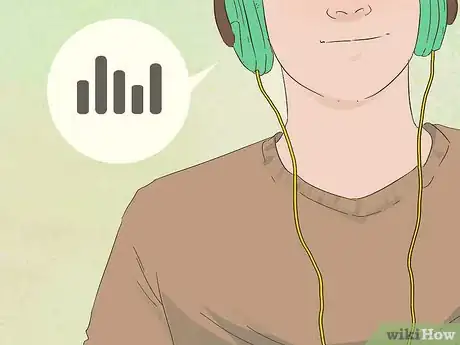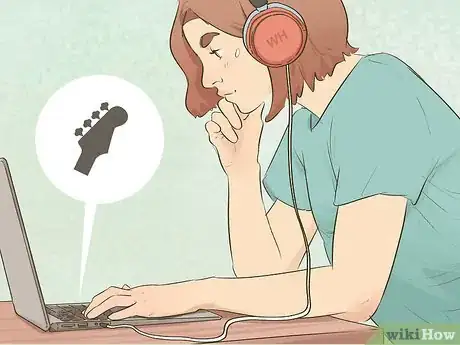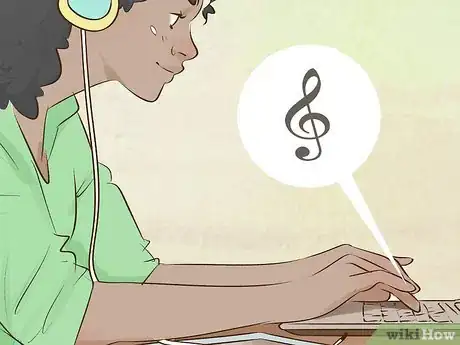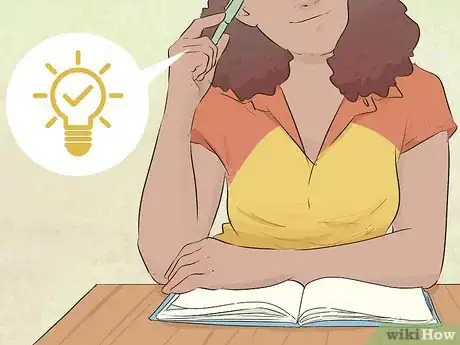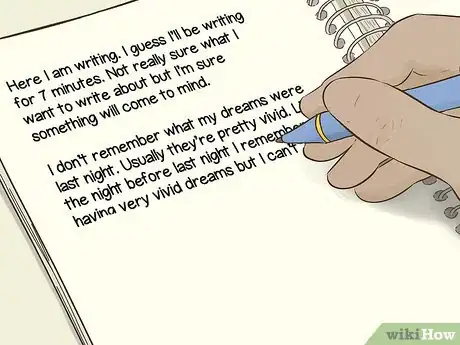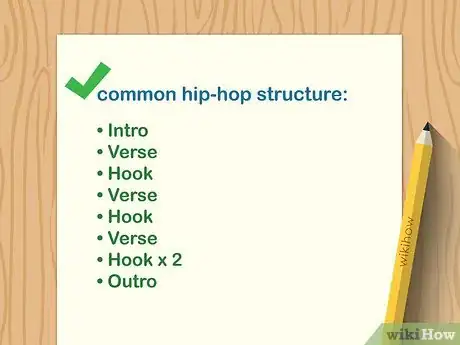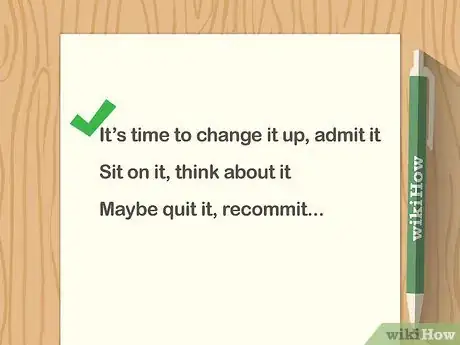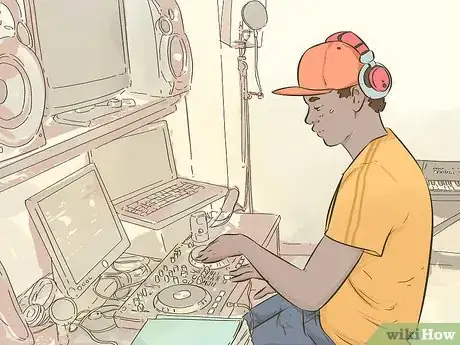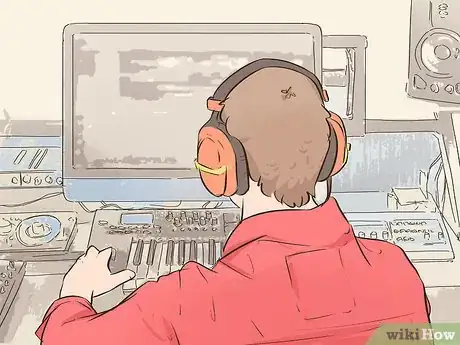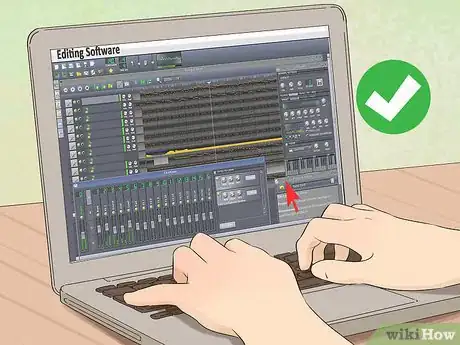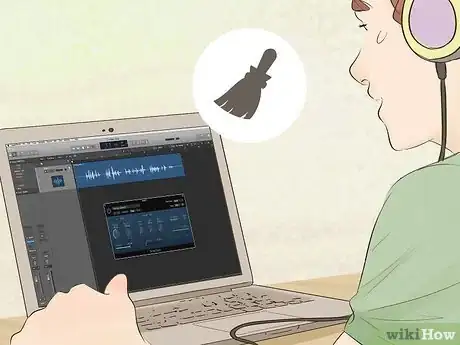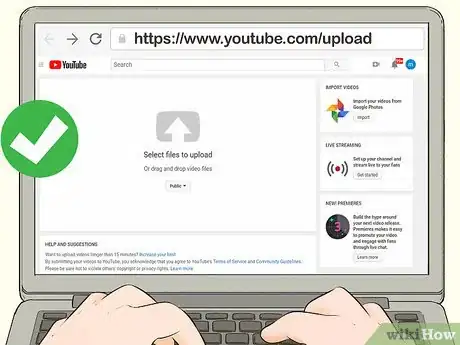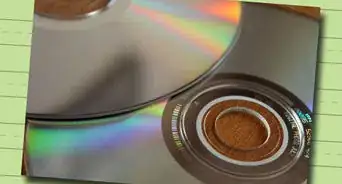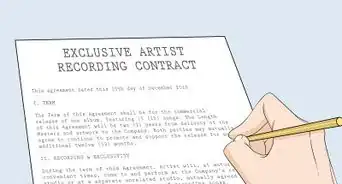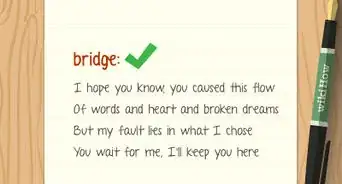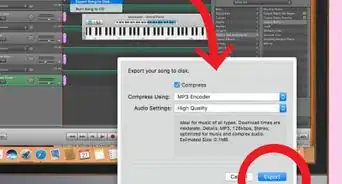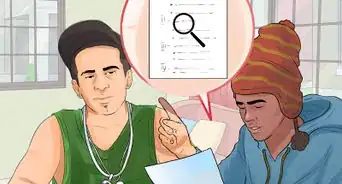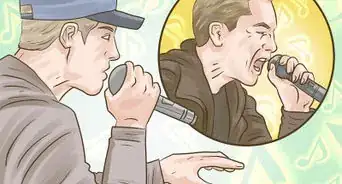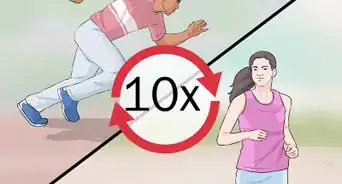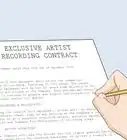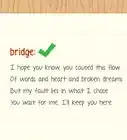This article was co-authored by wikiHow Staff. Our trained team of editors and researchers validate articles for accuracy and comprehensiveness. wikiHow's Content Management Team carefully monitors the work from our editorial staff to ensure that each article is backed by trusted research and meets our high quality standards.
There are 8 references cited in this article, which can be found at the bottom of the page.
This article has been viewed 97,730 times.
Learn more...
If mainstream hip-hop and its catchy, commercial flows aren’t for you, dig deep into the underground scene. Listen to other artists and pay attention to how their rhymes and rhythms work. and start coming up with beats and lyrics. Underground rap is all about authenticity, so write about subjects that light a fire inside you. Once you’ve written and revised your rap, record and produce your track. Then share it online and show off your talents to the world!
Steps
Creating Your Beat
-
1Pay attention to how beats drive hip-hop songs. When you listen to songs, notice how the beat anchors the rap. Count along with the beat to get a feel for how it organizes the lyrics and sets a song's tempo. Try to identify the instruments and sounds that make up a beat:
- The bassline, or the lowest tones that drive the rhythm.
- Additional percussion, or a combination of snare drums and cymbals that adds variety.
- The lead, which is a melody played by instruments such as a piano, guitar, or synthesizer.
- Add-ons that lend character, such as scratches and vocal effects.
-
2Use a digital audio workstation (DAW) to create your own beat. A DAW is software that allows you to create beats, record music, and mix tracks. Examples include FL Studio, Garageband (macOS only), and Audacity. Audacity and Garageband have free and paid options; FL Studio is considered the top DAW, but prices start at $99 (U.S., as of October 2018).[1]
Tip: Many artists prefer to start with a beat, while others begin by writing lyrics. Write your song in the order that it comes to you. For example, you might have a beat in mind, or find that you can’t get lyrics out of your head.
Advertisement -
3Start with your bassline and supplemental drums. The exact steps depend on your specific DAW program. In general, start by setting your bassline’s beats per minute (BPM); hip-hop songs are usually 100 to 140 BPM. Then select an instrument, such as a bass guitar or kick drum, from the bass folder drop-down menu.
- Play around with different instruments and tempos to get a feel for how the bassline works. Then add higher-pitched percussion, including snares and hi-hats, until you’ve found a combination that you like.
- For a simple 4/4 beat (4 beats per measure), you could play a kick drum on beats 1 and 3, a snare on beats 2 and 4. Play with 4-beat combinations with half, quarter, and eighth beats, too. For instance: kick-kick (first beat), snare (second beat), kick-kick (third beat), snare-snare (fourth beat).
-
4Add the melody and, if desired, add-ons. Select a lead instrument, such as a piano or guitar, for the melody. Play around with notes on the DAW grid display and come up with a tune that strikes the right chord for your ears. You can also incorporate scratches or record sounds like breathing or growling to make your tune more unique.
- Underground rap doesn’t need to be too polished, and you don’t need to add a catchy, “poppy” melody. If you just want a raw drum or bass beat, skip the lead instrument.
Writing Your Lyrics
-
1Brainstorm a topic that means something to you. Lyrically, underground hip-hop is diverse, and your song can be about any topic you want. That said, underground raps often focus on more meaningful, socially-conscious topics than commercial hip-hop. Additionally, it’s always best to write what you know, so think about aspects of your life experience that make you most passionate.[2]
- For instance, think about a personal struggle you went through, injustices that make you angry, or times in your life when you felt exhilarated or like you were invincible.
-
2Free-write blocks of text. During the brainstorming stage, don’t worry about rhyming or setting your words to a beat. Just think about your topic and write down whatever comes to mind. Tell a story, vent your emotions, and try to stay as true to your experience as possible.
- Worry about rhyming and other technical aspects later in the process. At this stage, focus on your rap’s meaning.
-
3Carve out your rap’s structure. Once you’ve put together some raw content, decide how to organize it. Think of your song like any other story: it should have a beginning, middle, and end. A common hip-hop structure is Intro/Verse/Hook/Verse/Hook/Verse/Hook x 2/Outro.
- As their names imply, the Intro introduces the listener to your rap, and the Outro offers a conclusion. For instance, introduce the struggles you faced growing up, then focus on a specific life event in each verse. In the Outro, talk about how those struggles made you who you are today.
- The hook is like a chorus; it’s the catchy, attention-grabbing part of a song. It may be sung lyrics, a sample from another song, or a repeated rap lyric.
- Don’t feel obligated to include a hook. Being catchy isn’t the purpose of an underground rap, and you don't need to conform to any standards. If a simple Intro/Verse/Outro structure is the best way to tell your story, go with it.
-
4Set your lyrics to your beat. Play your beat, and revise your lyrics so they match up with your rhythm. Most hip-hop songs follow a 4/4 time signature, which means there are 4 beats per measure. To match a 4/4 beat, organize your lyrics into bars with 4 stressed syllables per line.
- Change phrases around and play with various word combinations to fit your beat. If you can’t think of an alternative word or phrase, look for synonyms in a thesaurus.
- Take Most Def's lyric “Yo, check it one for Charlie Hustle, two for Steady Rock/ Three for the fourth comin' live, future shock.” In each line, 4 syllables are stressed, like this: “Yo, check it ONE for Charlie HUSTle, TWO for Steady ROCK/ THREE for the FOURTH comin' LIVE, future SHOCK.”
- If you haven't come up with an instrumental beat yet, set your lyrics' rhythm, such as by dividing it into 4/4 bars. Then play around with your DAW to come up with a beat that fits your rap's rhythm.
-
5Focus on rhyming after you’ve laid down the meaning. Now that your lyrics are structured and follow the beat, swap out words to create a rhyme scheme. Look up words in a rhyming dictionary, and insert rhymes within and at the end of lines. In addition, use devices such as assonance, or the repetition of a vowel sound, and consonance, or the repetition of a consonant.
- You could make couplets so 2 lines in a row rhyme, make every other line rhyme, or mix it up with an irregular rhyme scheme. Consider the opening lines from Wu Tang Clan’s “A Better Tomorrow:”
Yo, in the housing, thousands seen early graves
Victims of worldly ways, memories stays engraved
All my live brothers, is locked down with high numbers
The young hunger, blind to these lies, they die younger - These bars are packed with examples of assonance, including “housing, thousands,” “graves...ways...engraved,” and “blind...lies...die.” The first and second lines rhyme, and “numbers” and “younger” in the third and fourth lines aren’t identical, but they repeat similar sounds. Finally, in the fourth line, “hunger” and “younger” form an internal rhyme.
- You could make couplets so 2 lines in a row rhyme, make every other line rhyme, or mix it up with an irregular rhyme scheme. Consider the opening lines from Wu Tang Clan’s “A Better Tomorrow:”
-
6Rewrite, revise, and reorganize your track. Memorize your rap’s rough draft and practice performing it. Pay attention to rough spots, look for ways to improve your rhythm and rhyme schemes, and make sure your ideas are organized.[3]
Tip: Try making a dry recording of your rap. It doesn’t need to be professional, so just use your phone or a recorder. Listen to your recording, take notes, and make adjustments. You can also play it for a few knowledgeable friends and ask for feedback.
Recording Your Song
-
1Invest in a microphone, preamp, computer, and DAW. Your most affordable mic option is a USB mic. Dynamic mics deliver higher quality, but they’re expensive and require a preamp (the mic connects to the preamp, and the preamp connects to a computer). As far as computers go, use one with a minimum of 4 GB of RAM (preferably at least 8 GB) to run your DAW and mix your track.[4]
- Don’t feel like you have to shell out lots of money all at once. Start with basic equipment and make upgrades gradually. A good smartphone can produce quality recordings, and there are free DAW apps available, such as Garageband (macOS only), Audacity, and Pro Tools First.
-
2Set up a home recording studio. If possible, set up your recording studio in a room without windows. A sofa, bookcases, and other furniture with various shapes can help dampen sounds. You could also invest in foam soundproofing panels for the walls, ceilings, and corners.[5]
- If you’re on a budget, try lining doors, windows, and walls with blankets, pillows, and egg carton material.
-
3Lay down your vocals and add-ons over your instrumental track. Play your beat and spit out your rap. Make 3 to 4 recordings of your vocal track, then record any add-ons, sound effects, or background vocals.[6]
Tip: Set your mic to low and keep it close to the side of your mouth to avoid picking up background noise. You're more likely to pick up unwanted sounds if the mic is set to high.[7]
-
4Label your tracks. Keep your individual instrumental, vocal, and add-on tracks organized on your DAW interface. In addition to labeling them, your DAW should allow you to color code individual tracks. That way, you can easily tell which track is which when you’re editing your song.[8]
- For instance, choose blue for drums, red for main vocals, and orange for add-ons. Right click a track or check your DAW interface for an “Options” or “Preferences drop-down menu. Look for an option such as “Set track label to custom color.”
-
5Clean up any accidentally recorded sounds. You could set up a noise gate on your DAW that mutes signals outside of a specified pitch and decibel range. That way, any clicks or bumps outside of your voice or beats range will be automatically removed. You can also manually edit out any accidentally recorded sounds.[9]
- The exact steps depend on your program. Some apps also have quick and easy automated clean-up functions.
-
6Adjust your tracks’ volume levels. Adjust each individual track’s volume until you’ve found the right balance. The individual parts should be distinct, but the song should be cohesive. You can also use your DAW's compression tool to limit your song’s frequency range.[10]
- A compressor automatically raises quieter volumes and lowers higher volumes. That way, your song’s volume will be consistent from start to finish.
-
7
Community Q&A
-
QuestionHow to get more lyrics?
 Kalij2020Community AnswerSometimes you just need to wait until you're inspired. A lot of people can't write something on the spot because they need to think deeply about the subject they want to make a song about. Give it time and it'll come to you.
Kalij2020Community AnswerSometimes you just need to wait until you're inspired. A lot of people can't write something on the spot because they need to think deeply about the subject they want to make a song about. Give it time and it'll come to you. -
QuestionHow do I come up with an original rap name?
 BrittanyCommunity AnswerPick a name that sounds good and that could attract a lot of attention. Use your imagination,and come up with cool and interesting names, but always remember, before picking any name for anything, make sure you like it.
BrittanyCommunity AnswerPick a name that sounds good and that could attract a lot of attention. Use your imagination,and come up with cool and interesting names, but always remember, before picking any name for anything, make sure you like it. -
QuestionHow can I get music for my rap?
 Community AnswerYou can make your own music on a website. I recommend "JamStudio" and "Soundation".
Community AnswerYou can make your own music on a website. I recommend "JamStudio" and "Soundation".
References
- ↑ https://deviantnoise.com/music-production/beat-making/
- ↑ https://www.powerpoetry.org/actions/7-tips-writing-rap
- ↑ https://www.smartrapper.com/make-rap-song/
- ↑ https://www.smartrapper.com/make-rap-song/
- ↑ https://www.soundonsound.com/techniques/room-improvement
- ↑ https://www.smartrapper.com/make-rap-song/
- ↑ https://theproaudiofiles.com/mixing-rap-vocals/
- ↑ https://transom.org/2014/pro-tools-3-mixing-basics/
- ↑ https://www.soundonsound.com/techniques/advanced-gating-techniques-part-1
